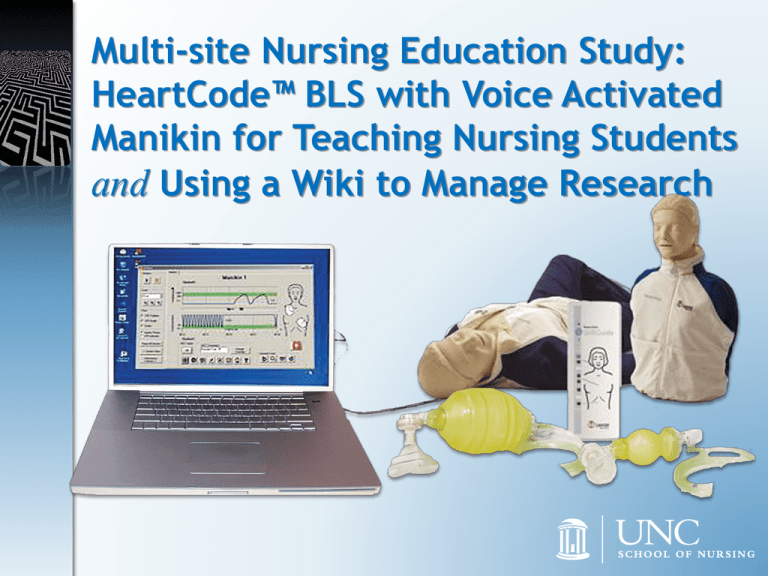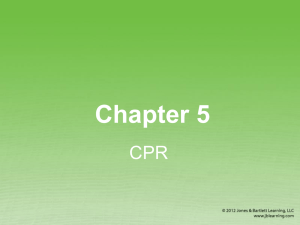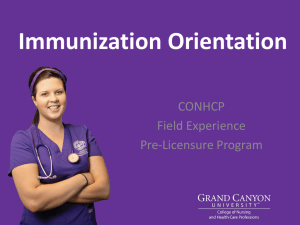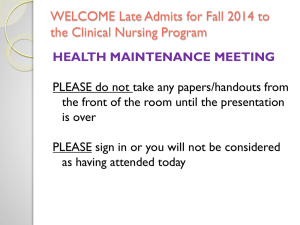Multi-Site Nursing Education Study: HeartCode BLS
advertisement

Multi-site Nursing Education Study: HeartCode™ BLS with Voice Activated Manikin for Teaching Nursing Students and Using a Wiki to Manage Research Research Team and Sites Marilyn H. Oermann, PhD, RN, FAAN, ANEF & Yeongmi Ha, MSN University of North Carolina at Chapel Hill, School of Nursing, Chapel Hill, NC Suzan E. Kardong-Edgren, PhD, RN, Tamara Odom-Maryon, PhD & Denise A. Smart, DrPH, RN Washington State University, College of Nursing, Spokane, WA Beth F. Hallmark, MSN, RN & Sharon Wilson Dowdy, PhD, RN Gordon Inman College of Health Sciences and Nursing Belmont University, Nashville, TN Jacqueline K. McColgan, MS, RN, CNE Debbie Hurd, MS, RN Nancy Rogers, MA, RN Springfield Technical Community College, Springfield, MA Collin County Community College, McKinney, TX Carroll Community College, Westminster, MD Leandro A. Resurreccion, MSN, RN Catherine Snelson, MSN, APRN Oakton Community College, Des Plaines, Il Kent State University, Kent, OH Carol Haus, PhD, RN, CNE West Penn Hospital School of Nursing, Pittsburgh, PA Dawn R. Kuerschner, MS, APN, NNP-BC, RNC, CNE Oakton Community College, Des Plaines, Il Jerrilee LaMar, PhD, RN, BC& Joan Fedor-Bassemier, MSN University of Evansville, Evansville, IN Monica Nelson Tennant, MSN, CCNS Byrdine F. Lewis School of Nursing, Georgia State University, Atlanta, GA Acknowledgement The project was coordinated through the National League for Nursing. Funding was provided by the American Heart Association and Laerdal Medical Corporation. Need for CPR Skills Nursing students need understanding of CPR and ability to perform CPR psychomotor skills Students may complete CPR course prior to entering nursing program or beginning their clinical practice Ability to perform CPR is critical Research evidence: Chances for patient survival improve with immediate and high quality CPR Lack of Retention of CPR Knowledge and Skills CPR skill deteriorates more rapidly than knowledge Reasons for poor retention Insufficient practice of CPR Too much time between course and actual practice Lack of feedback during learning Lack of consistency in and quality of CPR instruction Complexity of CPR skills Research Evidence Limited research with nursing students Madden (2006): Retention of CPR skills of students (n=55) in Ireland Students acquired CPR knowledge and skills following instructor-led (IL) course Could not pass CPR skill assessment at any time in study Displayed significant deterioration of skills at 10-week posttest Research Evidence Kardong-Edgren & Adamson (2009): Assessed videotapes of students performing CPR 22 weeks after passing CPR course No student could correctly perform CPR Leighton & Scholl (2009): Simulation of adult with unexpected cardiac arrest Students recently had BLS course and were certified Most could not implement BLS actions in correct order during simulation Instructor-led CPR Courses Most common Issues Pace of course preset: Limited practice time Instructors may not accurately assess performance or correct errors Lynch, Einspruch, Nichol, & Aufderheide (2008): 826 lay persons trained in CPR CPR skills assessed by 13 certified instructors and on manikins with Laerdal PC SkillReporting™ software Instructors rated accurately ventilation skills, but not chest compressions or hand placement Video Self-instruction Batcheller et al. (2000): 202 lay persons randomly assigned to IL course or video self-instruction More accurate compressions and ventilations with video Overall performance also better in video group Einspruch, Lynch, Aufderheide, Nichol, & Becker (2007): Retention of CPR skill same with video self-instruction compared to IL course Voice Activated Manikin (VAM) Provides immediate verbal feedback about performance and how to correct it “Compress faster” “Ventilate more slowly” Systematic review by Yeung et al. (2009): Practice with VAM improves CPR skill acquisition and retention Quality of CPR HeartCode BLS American Heart Association (AHA) Self-directed, electronic course for obtaining basic life support (BLS) certification 2 parts Part 1: Knowledge of BLS Part 2: CPR psychomotor skills Completed with either AHA-certified instructor or voice-activated mannequin (VAM) HeartCode BLS: Part 1 Computer-based didactic component Video lessons that teach BLS Guide students through BLS algorithms and skills Case scenarios Students assess patients and decide on treatment Simulated patients respond Microsimulation technology HeartCode BLS: Part 1 Debriefing screen Online report explaining incorrect and correct actions Remediation with links to answers Test cont. at end of cognitive portion Must score 84% to pass HeartCode BLS: Part 2 Learn and practice CPR psychomotor skills on sensored Resusci AnneTM adult and infant manikins (VAMs) At end of cycle manikin asks if want to continue practicing or use completed cycle as CPR skills test Pass psychomotor portion of BLS course Need for Research No studies have examined HeartCode BLS or use of VAMs for CPR training with nursing students Limited skill development with IL course Rapid loss of CPR knowledge and skills Is taking the standard, IL CPR course worth it? Purpose of Study Evaluate effectiveness of HeartCode BLS with VAM for teaching nursing students Students learned and practiced CPR psychomotor skills on VAMs Part of larger multi-arm study Methods Experimental design 10 schools randomly assigned to 2 types of CPR training: 1. 2. HeartCode BLS or Standard 4-hour instructor-led BLS Healthcare Provider course Students completed type of CPR training randomly assigned to their school Types of CPR Training HeartCode BLS with VAM system or Standard IL BLS course Coordinators contacted certified instructors in their geographic areas to present course Practiced on regular manikins provided by instructor None were VAMs Knowledge test in paper and pencil format CPR skill assessed by instructor observing students perform CPR on manikin Sample Type of Program N (%) Diploma 81 (13.8) Associate 258 (43.8) Baccalaureate 250 (42.4) HeartCode BLS Instructor-led BLS Course 258 (43.8%) 331 (56.2%) 30.5 (SD=9.0) years 26.1 (SD=8.6) years, p=<0.001 Assessment of CPR Psychomotor Skills After passing BLS courses and receiving AHA certification, students’ CPR skills assessed using Laerdal PC SkillReporting System 3-minutes each of compressions, ventilations, and single rescuer CPR Laerdal PC SkillReporter System Kept ongoing logs Provided monitor display of each compression and ventilation Incorrect hand placement shown with “hand” icon on screen Monitor displays visible only to site coordinators Data on performance of CPR skills sent electronically to statistician Measures 1. Number of ventilations performed correctly 2. Volume between 500-800 ml Inflation flow rate < 800 ml/second Airway open during inflation part of ventilation Number of compressions performed correctly Depth between 38-51 mm Completely released Correct hand position Site Coordinators 1-2 per school Roles Implement protocol Set up and use VAMs Collect and transmit data Manage project at site Preparation of Coordinators Face-to-face meeting at simulation center Periodic conference calls Development and use of wiki Findings Students who had HeartCode BLS and practiced on VAM had better CPR skills than students who had standard IL course HeartCode BLS group More ventilations without errors (p = 0.03) More compressions done correctly (p = 0.002) More accuracy with single rescuer CPR (p < 0.001) Differences in CPR Skills between HeartCode BLS and IL Courses CPR Skills Ventilations with no errors Compressions with no errors Incorrect hand position during compressions Ventilations with no errors during single rescuer CPR Number of compressions with no errors during single rescuer CPR Type of CPR Course HeartCode IL M (SD) M (SD) p 16.1 (14.2) 7.6 (11.8) 0.03 147.0 (108.3) 83.8 (108.3) 0.004 51.5 (100.2) 0.03 25.1 (68.8) 5.2 (4.9) 3.0 (3.6) 0.001 119.8 (72.4) 62.3 (70.4) <0.001 Discussion HeartCode BLS with practice on sensored Resusci Anne manikins Significantly more effective Students performed more ventilations, compressions, and single rescuer CPR without errors than students who had standard IL course Advantages of HeartCode BLS Part 1 Self-paced and interactive Review concepts until achieve mastery At time convenient for students Simulated case scenarios for application of concepts Debriefing built into program for immediate feedback For review as students progressed through nursing program Disadvantages of HeartCode BLS Part 1 Cost Use of IL course by tradition Voice Activated Manikins Advantages Immediate feedback on performance and how to correct it Feedback more specific than in IL course Practice as needed Use to maintain CPR skills Disadvantages English as second language Students over- and underweight “Every School Needs a VAM” Managing this Multi-site Study Schools of nursing throughout US 14-site coordinators Technology rich study Complexity of protocol Managing this Multi-site Study Work as research team Need for communication of important information Development of Wiki Our Wiki Uses of Wiki Communicate information to team members Share resources, forms, and other documents Foster collaboration Share experiences with study implementation (recruitment, issues, how resolved) Uses of Wiki Repository for information related to study Study protocol Calendars with data collection dates IRB and consent forms Data collection tools Information to implement study Study Documents on Wiki Uses of Wiki Avoid repetitive questions from large group Prepare abstracts and manuscripts Add and edit documents on Wiki Wiki Page for Writing Manuscripts Read More about our Wiki Kardong-Edgren, S.E., Oermann, M.H., Ha, Y., Tennant, M.N., Snelson, C., Hallmark, E., Rogers, N., & Hurd, D. (2009). Using a wiki in nursing education and research. International Journal of Nursing Education Scholarship, 6(1), Article 6. DOI: 10.2202/1548-923X.1787 http://www.bepress.com/ijnes/vol6/iss1/art6








